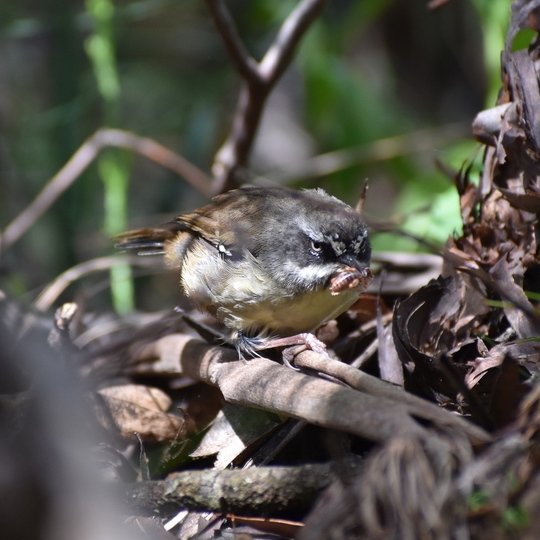Wee Little Bird
Striated Fieldwren by Andrew Allen, CC BY 4.0, via iNaturalist
Acanthizidae
by Inspector Barry Mins on February 27, 2024Hey kids, welcome back to our series on the mysteries of created kinds.
Last week, we met a colorful Southeast Asian newt. This week, we go south into Australasia and look for a group of small birds.

There are about 67 species of this kind, and they live in Australia, Indo-New Guinea, New Zealand, and many of the isolated islands in the south Pacific. Members of this group often join loose social groups if conditions are favorable. However, if the environment is more unforgiving, they will separate.1 In some species, there is variation in color based on geography.2 Depending on the habitat, food and foraging behaviors also vary.3
Breeding in this kind also varies significantly. Some species use helpers to aid them in building the nest and feeding the young, others do not.4 In some species, two nests are built, one real, where the female incubates the eggs, the other above it being a dummy to attract predators.5 Breeding goes on from roughly July to January. During that time, everything from nest building to chicks fledging occurs.6 Nests are built off the ground in low shrubs and trees, sometimes along the waterfront in species living in those habitats.7 Some species will reuse their nests over an extended period, in one case for 13 years!8
Has anyone figured it out yet? This week’s kind is the Acanthizidae—the Australian warbler kind.
Stay tuned for next week when we move to the West Coast of North America, looking for a group of Salamanders.
Try out this fun crossword!
Clue
Your clue for the week is:
It is unclear just how many species this kind has, but if you live on the West Coast of the US or Canada, you may have seen one.
Ask a Question
Have you ever had a question about created kinds but didn’t know who to ask? Have you ever wanted to learn more about your favorite kind? Well, now you can! You can ask me, Inspector Barry Mins, a question! Have your parents help you fill out this form, and you might get your question answered in my column! If you have any questions about created kinds, feel free to send them my way!
Footnotes
- Stephen J. Ambrose and Stephen J. J. F. Davies, “The Social Organization of the White-Browed Scrubwren Sericornis frontalis Gould (Acanthizidae) in Arid, Semi-Arid and Mesic Environments of Western Australia,” Emu 89, no. 1 (1989): 40–46, Google Scholar.
- A. Keast, “Geographic Variation in the Weebill, Smicrornis brevirostris (Gould) (Passeres: Muscicapidae, malurinae) a Sedentary Species with a Continuous Range,” Australian Journal of Zoology 6, no. 2 (1958): 152–161.
- Allen Keast and Harry F. Recher, “The Adaptive Zone of the Genus Gerygone (Acanthizidae) as Shown by Morphology and Feeding Habits,” Emu 97, no. 1 (1997): 1–17.
- Harry L. Bel and Hugh A. Ford, “A Comparison of the Social Organization of Three Synoptic Species of Australian Thornbill, Acanthiza,” Behavioral Ecology and Sociobiology 19, no. 6 (1986): 381–392, https://www.researchgate.net/profile/Hugh-Ford/publication/226757832_A_comparison_of_the_social_organization_of_three_syntopic_species_of_Australian_thornbill_Acanthiza/links/0912f508a5830a1d99000000/A-comparison-of-the-social-organization-of-three-syntopic-species-of-Australian-thornbill-Acanthiza.pdf.
- R. J. Brown and M. N. Brown, “Nest-Building Behaviour of the Yellow-Rumped Thornbill Acanthiza chrysorrhoa,” Australian Bird Watcher 11, no. 7 (September 1986): 218–223, https://afo.birdlife.org.au/afo/index.php/afo/article/viewFile/1035/1008.
- Brian J. Gill, “Breeding of the Grey Warbler Gerygone igata at Kaikoura, New Zealand,” Ibis 124, no. 2 (1982): 123–147, https://www.researchgate.net/profile/Brian-Gill-2/publication/227933462_Breeding_of_the_grey_warbler_Gerygone_igata_at_Kaikoura_New_Zealand/links/5a167c1b4585153b546cd4dd/Breeding-of-the-grey-warbler-Gerygone-igata-at-Kaikoura-New-Zealand.pdf.
- Richard A. Noske, “The Breeding Biology of the Mangrove Gerygone, Gerygone laevigaster, in the Darwin Region, with Notes on Brood Parasitism by the Little Bronze-Cuckoo, Chrysococcyx minutillus,” Emu 101, no. 2 (2001): 129–135.
- Peter Smith and Judy Smith, “Re-Use of a Rockwarbler Origma solitaria Nest over a 13-Year Period,” Australian Field Ornithology 29, no. 2 (June 2012): 77–82, https://www.researchgate.net/profile/Peter-Smith-110/publication/290733038_Re-use_of_a_Rockwarbler_Origma_solitaria_nest_over_a_13-year_period/links/5e8fe0cca6fdcca7890633f8/Re-use-of-a-Rockwarbler-Origma-solitaria-nest-over-a-13-year-period.pdf.
- © 2024 Answers in Genesis
- Privacy Policy
- Contact
- About



